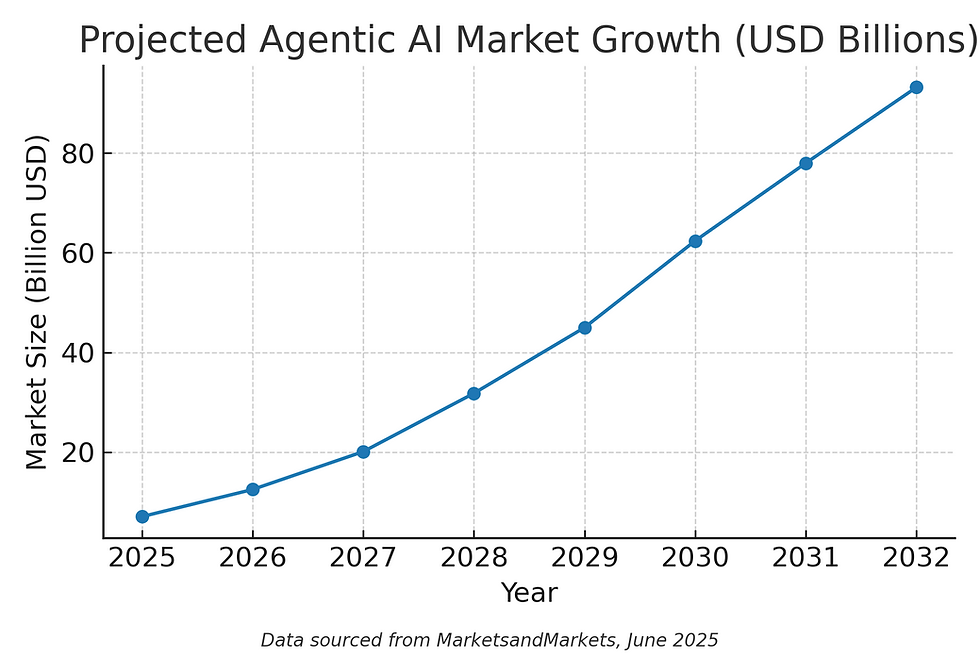Agentic AI: Is it here to stay?
- Capacitor Partners

- Aug 10
- 3 min read

The Shift from Assistance to Autonomy
Agentic AI represents a significant departure from the predictive and assistive AI models of the last decade. As Gartner notes, this new generation of AI systems can independently initiate actions, make decisions, and execute complex workflows with minimal human intervention. Where traditional AI served as a tool to support human judgment, agentic AI acts as a digital co-worker capable of managing entire processes end-to-end.
By 2029, Gartner forecasts that these autonomous agents will resolve 80 percent of common customer service issues without human involvement, cutting operational costs by 30 percent. For enterprises, the appeal is clear: faster decision-making, reduced manual workloads, and scalable execution.
Market Momentum and Investment Flows
The commercial opportunity is immense. MarketsandMarkets projects the agentic AI market to grow from USD 7.06 billion in 2025 to USD 93.20 billion by 2032, a compound annual growth rate of 44.6 percent. The rise is driven by the convergence of generative AI, orchestration frameworks, and reinforcement learning, enabling agents to adapt to dynamic environments, integrate with enterprise systems, and execute without constant human prompting.

DigitalDefynd’s industry scan underscores the pace of adoption: over 60 percent of new enterprise AI deployments in 2025 are expected to include agentic capabilities, while more than 45 percent of Fortune 500 companies are piloting agentic AI in production environments. Venture capital has poured over USD 9.7 billion into startups in this space since 2023, reflecting investor confidence in its transformative potential.
Operational Impact Across Functions
Real-world implementations already demonstrate measurable results. Zendesk and Intercom pilots reported a 63 percent reduction in average customer support resolution time. Legal firms have seen a 41 percent productivity boost in drafting work. In manufacturing, agentic AI has cut downtime by a third through autonomous fault detection. Gartner forecasts that by 2028, 15 percent of day-to-day enterprise decisions will be made autonomously and a third of enterprise software will embed agentic capabilities.

The Risk of Overreach
Despite its promise, the technology faces serious execution challenges. Sol Rashidi (Forbes) reports that more than 40 percent of agentic AI projects will be canceled by 2027, often due to unclear ROI, integration costs, and immature governance. Anushree Verma of Gartner cautions that many early efforts are rebranded versions of older automation or AI tools, falling short of true autonomy.
Eric Siegel (Forbes) warns of a hype cycle at its peak, with “agentic AI” often serving as a repackaging of generative AI advances rather than a distinct technical breakthrough. This inflated narrative risks a sharp fall into disillusionment if expectations outpace delivered value.
Governance, Data, and Human Integration
As organizations deploy autonomous systems, they must address governance, security, and data quality. Poor data can compromise decisions. Low-code agentic solutions developed outside IT oversight introduce vulnerabilities. Such developments stress the need for policies that define the scope of agent autonomy, set escalation protocols, and integrate human oversight into decision loops.
Equally important is preparing employees to work alongside autonomous agents. Gartner advocates a hybrid model where human intelligence complements machine capabilities, supported by training programs to build fluency in managing AI-driven workflows.
The Verdict
The winners in this next phase will be those who implement agentic AI with discipline and clear business objectives. High-impact applications include decision-making tasks, complex workflow automation, and enterprise productivity gains where human oversight remains integral.
Leaders should avoid deploying agents simply to showcase innovation. Instead, they should target bottlenecks where autonomy can generate measurable improvements, redesign workflows to accommodate AI-led execution, and establish robust metrics for performance.
Agentic AI is not a passing fad. It is an architectural shift in how organizations design work, engage customers, and make decisions. But its success will not hinge on who adopts first. It will depend on who can sustain deployment beyond the hype, integrating autonomy in ways that are secure, ethical, and value-driven.
The next decade will reveal which enterprises can turn this technology into a durable competitive advantage and which will be left in the trough of unmet expectations.
Are you considering a digital transformation? Learn why industry leaders from across the world trust Capacitor Partners with their transformation needs. Contact us for an appointment




Comments